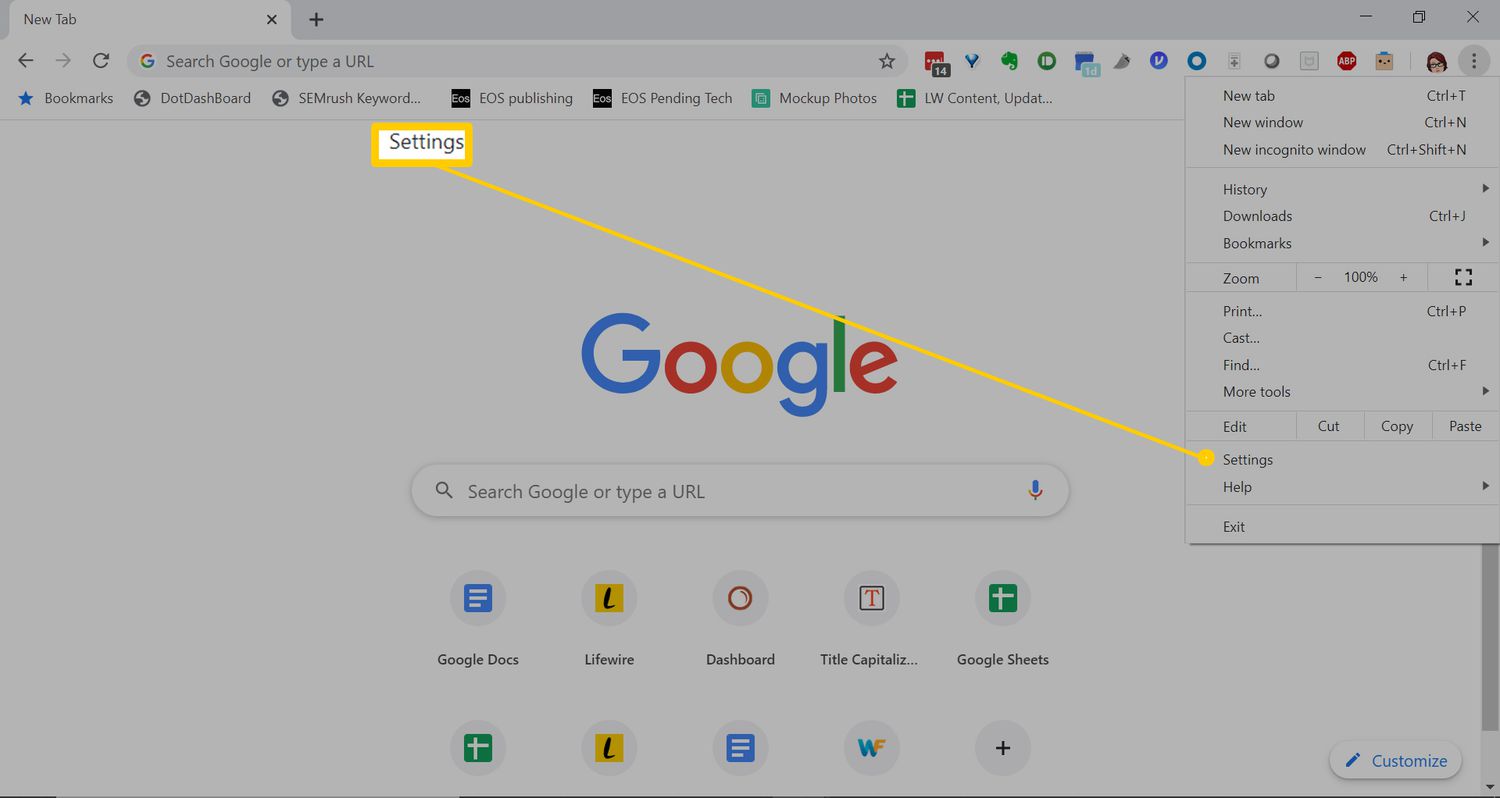Introduction
Google Chrome, the widely popular web browser, offers a plethora of features that cater to the diverse needs of its users. One of the most compelling aspects of Chrome is its extensive collection of add-ons, also known as extensions, which enhance the browsing experience by providing additional functionality and customization options. Whether you're a productivity enthusiast, a design aficionado, or a security-conscious individual, Chrome's add-ons offer a myriad of solutions to amplify your online activities.
In this comprehensive guide, we will delve into the realm of Chrome add-ons, exploring the various facets of managing, installing, removing, and updating these invaluable tools. By the end of this journey, you will be equipped with the knowledge and skills to harness the full potential of Chrome add-ons, empowering you to tailor your browsing experience to your unique preferences and requirements.
Let's embark on this enlightening expedition into the world of Chrome add-ons, where innovation, convenience, and personalization converge to redefine the way we interact with the web.
Understanding Chrome Add-Ons
Chrome add-ons, also referred to as extensions, are small software programs that modify and enhance the functionality of the Google Chrome web browser. These add-ons are designed to cater to a wide spectrum of user needs, ranging from productivity and organization to entertainment and security. By seamlessly integrating with the browser, add-ons empower users to personalize their browsing experience, streamline tasks, and access specialized features that align with their preferences.
Types of Add-Ons
Chrome add-ons encompass a diverse array of categories, each serving a distinct purpose. Productivity add-ons, such as task managers and note-taking tools, aim to optimize workflow and efficiency. Design and creativity add-ons offer graphic design, photo editing, and color scheme tools to unleash artistic expression. Security add-ons bolster browsing safety by blocking malicious websites and safeguarding sensitive information. Additionally, entertainment add-ons provide access to games, music, and video streaming platforms, enriching the leisure aspect of browsing.
Benefits of Chrome Add-Ons
The versatility of Chrome add-ons empowers users to tailor their browsing experience to suit their individual needs and preferences. Whether it's streamlining daily tasks, bolstering online security, or infusing creativity into web activities, add-ons offer a myriad of benefits. They enable users to customize their browser interface, access specialized tools without leaving the browser, and enhance productivity by automating repetitive tasks. Furthermore, add-ons contribute to a more secure browsing environment by providing ad-blocking, anti-phishing, and password management functionalities.
Accessibility and Installation
Chrome add-ons are readily accessible through the Chrome Web Store, a centralized platform where users can explore, select, and install their desired extensions. The installation process is straightforward, typically requiring just a few clicks to add an extension to the browser. Once installed, the add-on integrates seamlessly with the browser interface, often displaying its icon in the toolbar for easy access.
Compatibility and Integration
Chrome add-ons are designed to seamlessly integrate with the browser, ensuring compatibility and stability. They are engineered to function harmoniously with Chrome's core features, minimizing potential conflicts and performance issues. This integration enables users to leverage the full potential of the add-ons without compromising the browser's speed or reliability.
In essence, Chrome add-ons are invaluable tools that empower users to personalize, optimize, and secure their browsing experience. By understanding the diverse categories, benefits, accessibility, and integration of these add-ons, users can harness their full potential to elevate their online activities.
Managing Add-Ons in Chrome
Managing add-ons in Google Chrome is essential for optimizing the browsing experience and ensuring that the browser remains streamlined and efficient. Whether it involves installing new add-ons, removing unnecessary ones, or updating existing extensions, effective management is key to maintaining a well-tailored and secure browsing environment.
Organizing Add-Ons
Upon accumulating a collection of add-ons, it's beneficial to organize them for easy access and navigation. Chrome provides the option to group add-ons based on categories or functionalities, allowing users to create a personalized system that aligns with their browsing habits. By categorizing add-ons, users can swiftly locate and utilize specific extensions, thereby enhancing productivity and convenience.
Monitoring Performance Impact
As the number of installed add-ons increases, it's important to monitor their impact on browser performance. Some add-ons may consume significant system resources, potentially slowing down the browser or causing instability. Chrome offers built-in tools to monitor the performance impact of add-ons, enabling users to identify and address any extensions that may be affecting the browser's speed or responsiveness.
Enabling and Disabling Add-Ons
Chrome provides the flexibility to enable or disable add-ons based on immediate requirements. This feature is particularly useful when certain add-ons are only needed for specific tasks or under particular circumstances. By selectively enabling and disabling add-ons, users can streamline the browser's functionality, ensuring that only essential extensions are active at any given time.
Customizing Add-On Settings
Many add-ons in Chrome offer customizable settings that allow users to tailor their functionality to specific preferences. These settings may include options for adjusting behavior, appearance, or interaction with other web elements. By exploring and customizing add-on settings, users can fine-tune their browsing experience to align with their unique requirements, thereby maximizing the utility of each extension.
Ensuring Security and Privacy
Effective add-on management involves prioritizing security and privacy. It's crucial to regularly review the permissions granted to each add-on and ensure that they align with the user's trust and privacy standards. Additionally, staying informed about the reputation and security practices of add-on developers can contribute to a more secure browsing environment.
By actively managing add-ons in Chrome, users can maintain a well-organized, efficient, and secure browsing experience, ensuring that their collection of extensions remains aligned with their needs and preferences. This proactive approach to add-on management empowers users to harness the full potential of Chrome's extensive library of extensions while optimizing their browsing environment for productivity and security.
Installing Add-Ons
Installing add-ons in Google Chrome is a straightforward process that grants users access to a wealth of additional functionalities and customization options. Whether you're seeking to bolster productivity, enhance security, or infuse creativity into your browsing experience, the Chrome Web Store offers a diverse array of add-ons to cater to your specific needs.
Exploring the Chrome Web Store
To begin the journey of installing add-ons, users can navigate to the Chrome Web Store, the official repository for Chrome extensions. Here, they can explore a vast collection of add-ons across various categories, including productivity, design, security, entertainment, and more. The intuitive interface of the Chrome Web Store facilitates seamless browsing, enabling users to discover and evaluate add-ons based on ratings, reviews, and detailed descriptions.
Selecting and Installing Add-Ons
Once a desirable add-on has been identified, the installation process is as simple as clicking the "Add to Chrome" button. This initiates the installation of the add-on, integrating it with the browser's interface. Upon successful installation, the add-on's icon typically appears in the browser toolbar, providing convenient access to its functionalities.
Exploring Featured and Recommended Add-Ons
In addition to browsing through the extensive collection of add-ons, users can explore featured and recommended extensions curated by the Chrome Web Store. These selections often highlight popular, innovative, or trending add-ons, offering users valuable insights into the latest and most impactful extensions available for Chrome.
Leveraging User Reviews and Ratings
User reviews and ratings play a pivotal role in the add-on selection process, providing valuable feedback and insights from the community of Chrome users. By considering the experiences and recommendations of fellow users, individuals can make informed decisions when choosing add-ons, ensuring that the selected extensions align with their expectations and requirements.
Exploring New Possibilities
The installation of add-ons opens up a world of new possibilities, empowering users to customize their browsing experience, streamline tasks, and access specialized tools without leaving the browser. Whether it's integrating a task manager, enhancing security with ad-blocking capabilities, or exploring innovative design tools, the installation of add-ons introduces a realm of customization and optimization to Chrome.
By embracing the process of installing add-ons, users can unlock the full potential of Google Chrome, tailoring their browsing experience to align with their unique preferences and requirements. This seamless integration of add-ons enriches the browsing journey, offering a personalized and enhanced environment that caters to diverse interests and objectives.
Removing Add-Ons
Removing add-ons from Google Chrome is a pivotal aspect of add-on management, enabling users to declutter their browser interface, optimize performance, and ensure that only essential and trusted extensions remain active. Whether an add-on is no longer needed, has become redundant, or is causing compatibility issues, the process of removing it is straightforward and empowers users to maintain a streamlined and efficient browsing environment.
Accessing the Extensions Menu
To initiate the removal of an add-on, users can access the Extensions menu in Google Chrome. This can be achieved by clicking on the three-dot menu icon in the top-right corner of the browser, navigating to "More tools," and selecting "Extensions." Alternatively, users can directly enter "chrome://extensions/" in the address bar to access the Extensions page.
Identifying and Removing Add-Ons
Upon accessing the Extensions page, users are presented with a comprehensive list of installed add-ons, each accompanied by its respective icon and details. To remove an add-on, users can simply locate the extension they wish to uninstall and click on the "Remove" or "Trash can" icon associated with it. A confirmation prompt may appear, requiring users to confirm the removal of the add-on.
Reviewing and Confirming Removal
Before finalizing the removal of an add-on, it's advisable for users to review any associated details or settings to ensure that the removal process aligns with their intentions. This may include reviewing the permissions granted to the add-on and considering any potential impact on browsing habits or workflows. Once the user is confident in their decision, they can proceed to confirm the removal of the add-on.
Streamlining the Browsing Experience
By actively removing unnecessary or obsolete add-ons, users can streamline their browsing experience, decluttering the browser interface and minimizing potential performance impacts. This proactive approach to add-on management contributes to a more efficient and organized browsing environment, ensuring that only essential and beneficial extensions remain active.
Ensuring Security and Privacy
In addition to optimizing performance, the removal of add-ons plays a crucial role in maintaining a secure and privacy-conscious browsing experience. Regularly reviewing and removing add-ons that are no longer needed or trusted helps mitigate potential security risks and minimizes the exposure of sensitive information to unverified extensions.
Embracing a Dynamic Browsing Environment
The ability to remove add-ons from Google Chrome empowers users to curate a dynamic and adaptable browsing environment, where the collection of extensions evolves in tandem with changing needs and preferences. This flexibility ensures that the browsing experience remains tailored, efficient, and aligned with the user's objectives.
By embracing the process of removing add-ons, users can actively shape and refine their browsing environment, ensuring that their collection of extensions remains purposeful, secure, and conducive to their browsing habits and objectives.
Updating Add-Ons
Keeping add-ons updated is crucial for ensuring optimal performance, security, and compatibility within the Google Chrome browser. As developers continually enhance their add-ons by introducing new features, addressing vulnerabilities, and improving overall stability, regular updates play a pivotal role in maintaining a seamless and secure browsing experience.
Importance of Updates
Add-on updates often encompass bug fixes, performance optimizations, and security patches, addressing potential vulnerabilities and enhancing the overall reliability of the extensions. By staying abreast of the latest updates, users can benefit from improved functionality, reduced security risks, and enhanced compatibility with the evolving landscape of web technologies.
Automatic Updates
Google Chrome simplifies the update process by offering automatic updates for installed add-ons. This feature ensures that users receive the latest versions of their extensions without manual intervention, thereby streamlining the maintenance of add-ons and minimizing the risk of using outdated or vulnerable versions.
Manual Update Checks
In addition to automatic updates, users have the option to manually check for updates for their installed add-ons. This can be done by accessing the Extensions page within Chrome, where users can review the update status of each extension and initiate manual update checks to ensure that they are leveraging the most recent versions.
Benefits of Timely Updates
Timely updates not only enhance the functionality and security of add-ons but also contribute to a more stable and efficient browsing experience. By promptly applying updates, users can mitigate potential performance issues, address compatibility concerns, and fortify the overall resilience of their browsing environment.
Ensuring Security and Reliability
Regular add-on updates are instrumental in fortifying the security and reliability of the browsing experience. As developers release updates to address security vulnerabilities and enhance privacy features, staying current with add-on updates helps users maintain a secure and trustworthy online presence.
Embracing Innovation and Improvement
By embracing add-on updates, users demonstrate a commitment to leveraging the latest innovations and improvements offered by developers. This proactive approach fosters a dynamic and evolving browsing environment, where add-ons continuously evolve to align with the latest industry standards and user expectations.
In essence, updating add-ons in Google Chrome is a fundamental practice that underpins a secure, efficient, and innovative browsing experience. By prioritizing timely updates, users can harness the full potential of their add-ons, ensuring that they remain at the forefront of functionality, security, and compatibility within the ever-evolving digital landscape.
Conclusion
In conclusion, the realm of Chrome add-ons represents a dynamic and transformative landscape that empowers users to personalize, optimize, and secure their browsing experience. By understanding the diverse categories, benefits, accessibility, and integration of these add-ons, users can harness their full potential to elevate their online activities.
The process of managing add-ons in Google Chrome is essential for optimizing the browsing experience and ensuring that the browser remains streamlined and efficient. From organizing add-ons and monitoring performance impact to enabling, disabling, and customizing add-on settings, effective management is key to maintaining a well-tailored and secure browsing environment.
Installing add-ons in Google Chrome is a seamless process that grants users access to a wealth of additional functionalities and customization options. By exploring the Chrome Web Store, selecting and installing add-ons, and leveraging user reviews and ratings, users can unlock the full potential of Google Chrome, tailoring their browsing experience to align with their unique preferences and requirements.
Removing add-ons from Google Chrome is a pivotal aspect of add-on management, enabling users to declutter their browser interface, optimize performance, and ensure that only essential and trusted extensions remain active. This proactive approach to add-on management contributes to a more efficient and organized browsing environment, ensuring that only essential and beneficial extensions remain active.
Keeping add-ons updated is crucial for ensuring optimal performance, security, and compatibility within the Google Chrome browser. By embracing add-on updates, users can actively shape and refine their browsing environment, ensuring that their collection of extensions remains purposeful, secure, and conducive to their browsing habits and objectives.
In essence, the comprehensive understanding and effective management of Chrome add-ons empower users to curate a dynamic and adaptable browsing environment, where the collection of extensions evolves in tandem with changing needs and preferences. This flexibility ensures that the browsing experience remains tailored, efficient, and aligned with the user's objectives.

























